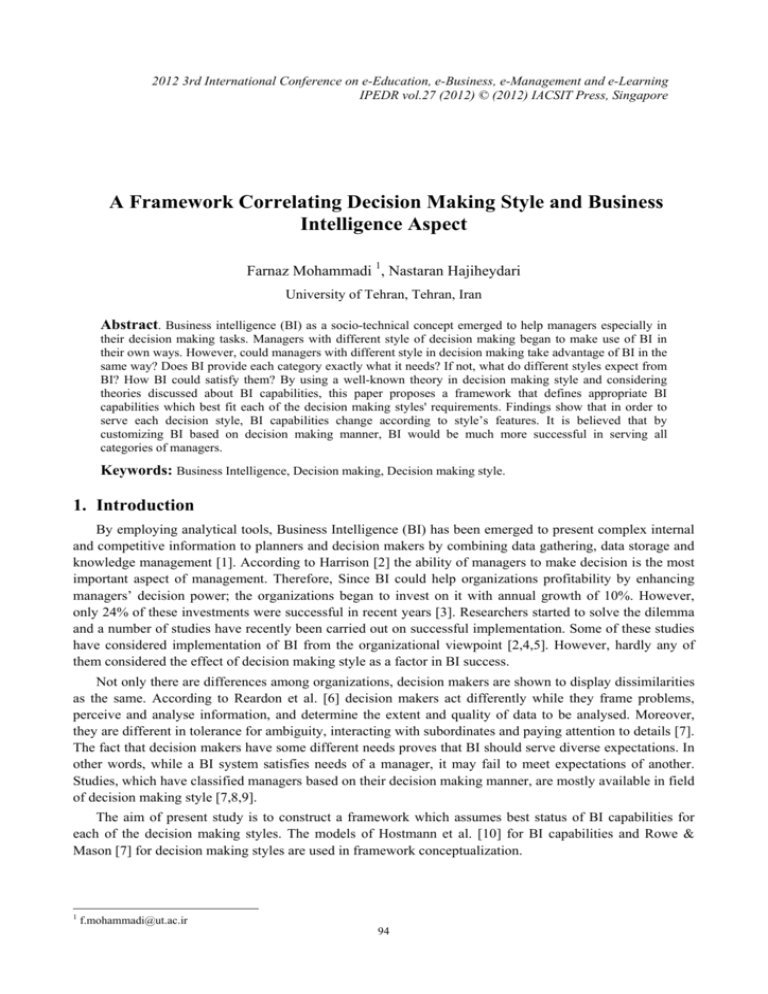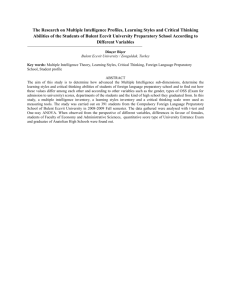A Framework Correlating Decision Making Style and
advertisement

2012 3rd International Conference on e-Education, e-Business, e-Management and e-Learning IPEDR vol.27 (2012) © (2012) IACSIT Press, Singapore A Framework Correlating Decision Making Style and Business Intelligence Aspect Farnaz Mohammadi 1, Nastaran Hajiheydari University of Tehran, Tehran, Iran Abstract. Business intelligence (BI) as a socio-technical concept emerged to help managers especially in their decision making tasks. Managers with different style of decision making began to make use of BI in their own ways. However, could managers with different style in decision making take advantage of BI in the same way? Does BI provide each category exactly what it needs? If not, what do different styles expect from BI? How BI could satisfy them? By using a well-known theory in decision making style and considering theories discussed about BI capabilities, this paper proposes a framework that defines appropriate BI capabilities which best fit each of the decision making styles' requirements. Findings show that in order to serve each decision style, BI capabilities change according to style’s features. It is believed that by customizing BI based on decision making manner, BI would be much more successful in serving all categories of managers. Keywords: Business Intelligence, Decision making, Decision making style. 1. Introduction By employing analytical tools, Business Intelligence (BI) has been emerged to present complex internal and competitive information to planners and decision makers by combining data gathering, data storage and knowledge management [1]. According to Harrison [2] the ability of managers to make decision is the most important aspect of management. Therefore, Since BI could help organizations profitability by enhancing managers’ decision power; the organizations began to invest on it with annual growth of 10%. However, only 24% of these investments were successful in recent years [3]. Researchers started to solve the dilemma and a number of studies have recently been carried out on successful implementation. Some of these studies have considered implementation of BI from the organizational viewpoint [2,4,5]. However, hardly any of them considered the effect of decision making style as a factor in BI success. Not only there are differences among organizations, decision makers are shown to display dissimilarities as the same. According to Reardon et al. [6] decision makers act differently while they frame problems, perceive and analyse information, and determine the extent and quality of data to be analysed. Moreover, they are different in tolerance for ambiguity, interacting with subordinates and paying attention to details [7]. The fact that decision makers have some different needs proves that BI should serve diverse expectations. In other words, while a BI system satisfies needs of a manager, it may fail to meet expectations of another. Studies, which have classified managers based on their decision making manner, are mostly available in field of decision making style [7,8,9]. The aim of present study is to construct a framework which assumes best status of BI capabilities for each of the decision making styles. The models of Hostmann et al. [10] for BI capabilities and Rowe & Mason [7] for decision making styles are used in framework conceptualization. 1 f.mohammadi@ut.ac.ir 94 This research brings together established theories from the decision sciences and information systems areas of research. First, the concept of Business Intelligence Systems and its’ capabilities are explained. Then decision making style concept is illustrated. This leads to a discussion of decision making style impact on BI. 2. Business intelligence Concept According to Brackett [11] BI is a set of concepts, methods and processes with ability of monitoring business trends, evolving and adapting quickly as situations change, making intelligent business decisions on uncertain judgements and exploration and analysis of unrelated information to provide relevant insights, identify trends and discover opportunities, the aim of which is to help business decision making. Academic works which have studied impact of organizational elements on BI are mostly available in BI success literature. However, studies in BI success seem immature and this subject requires more concentration. Among various factors affecting BI success, managerial factors are the ones which rely on organization features rather than BI competencies. McMurchy [12] considered management support as one of the BI success factors. Furthermore Williams & Williams [4] underlined connecting BI with organization strategy, culture and organizational strength to achieve BI profits. Hostman et al. [10] defined four organization environments and showed how BI is used in each of these four worlds. The differences between these environments were subject to two factors: first decision type which was divided into structured and unstructured parts, and second, information access and analysis that contained controlled and open dimensions. Employing Hostman et al. [10] model of BI capabilities, Isik [13] offered a model for BI success based on impacts of BI capabilities and decision environment. In his model, He discussed impacts of level of management and decision types on BI, however, similar to Hostman et al. [10], he only considered impacts of structural features of decision (structured or unstructured) on BI success. Moreover Chasalow [14] proposed a model of organizational and individual competencies for BI success. He not only realized organizational variables in his model, but paid attention to some personal traits such as leadership style which has democratic and autocratic dimensions. As seen in the literature, the impacts of decision maker style differences on BI have not been discussed. 2.1. BI capabilities Information technology (IT) research has mostly employed IT capabilities to discuss the role of IT in enhancing firm performance [15]. Similarly, studies in BI field manage to use BI capabilities in the same way, although there are not still enough studies in this area. Watson & Wixom [16] paid attention to this concept and called BI capabilities as functionalities of BI, playing a critical role in organization agility. Furthermore, eight important BI capabilities categorized into organizational and technical aspects have been discussed by Hostmann [10]. Since this study employs BI capabilities list proposed by Hostmann et al. [10], each BI specification is defined as below: • Data Source: Data source is where data resides and is retrieved for analytical usage which could be either internal or external. • Data Type: Data could be either dimensional or non-dimensional and numerical or nonnumerical. Dimensional data is structured and subject oriented and non-dimensional data is unstructured. Hostmann et al. [10] refer to dimensional and numerical data as quantitative and non-dimensional and non-numerical data as qualitative data. • Data Reliability: data reliability is dependent on data source whether it is qualified and controlled. • Flexibility: Flexibility as a BI capability indicates the amount of interaction a BI system have with variety of data sources and analytical tools. • Intuition Involved in Analysis: Analysing with intuition is based on feelings rather than facts. • Interaction with Other Systems: BI interactions with other systems indicate the level of communicability BI has with other parts. 95 • Risk Level: risk taker organizations have high tolerance for uncertainty and expect BI to support exploring new opportunities while organizations which are not risk takers have low tolerance for ambiguity and face specific problems. • User Access: BI systems could be classified into web-centric systems and specific desktop applications. The difference between these two is based on amount of control and limitations that users have in system access. [10,16] 3. Decision Making styles According to Driver [17] decision style is a habitual pattern that individuals use in the decision making process. To better illustrate decision style concept, there has been a number of various models proposed by researchers such as McKeeney & Keen [18], Driver et al. [8] and Scott and Bruce [9] to name a few. Among them, Rowe and Mason [7] framework has managed to shed more light on the information technology subject and to attract more attentions [19,20]. Rowe and Mason [7] proposed a framework with four decision styles. Their model considered how individuals (especially managers) make a particular decision based on two main dimensions: first, the way they make use of various levels of information and second, technical aspect of decisions which mostly relates to social matters. Therefore, according to Rowe and Mason [7], individuals fall into four categories while making decisions: directive, analytical, conceptual, and behavioural. Each of these categories will be illustrated in framework description. 4. Framework Proposition While BI tries to satisfy decision maker’s needs, there are some differences between decision makers’ interests due to their specific decision making style. Therefore this study suggests a conceptual framework that concentrates on BI capabilities according to characteristics of each of the decision making styles. Hostman et al. [10] BI capabilities are applied as BI dimension of the framework. In fact the eight dimensions discussed as the main aspects of BI contribution in business. On the other hand, Rowe and Mason [7] decision styles including four specific styles are placed on Decision dimension of the framework. The conceptual framework relating these two aspects is depicted in Table.1. Table 1: BI capabilities and Decision Style framework BI Capability Decision Making Style Directive Analytical Conceptual Behavioral Data Source Data Type Data Reliability Flexibility Intuition Involved in Analysis Interaction with Other Systems Risk Level User Access Internal Internal& external Internal & external Internal Quantitative Quantitative & qualitative quantitative & qualitative qualitative Individual System Low High Always Seldom Low High Low Low Specific Specific individual High Always High High individual High Seldom High Low Webcentric Webcentric • Directive. Individuals with directive style tend to acquire information by sensing and prefer to receive brief reports with limited data verbally. Therefore, in receiving data they rely on individuals. In analysing information, they use intuition, experience and rules. Pure facts, rules and procedures are kinds of information that are most valued by directive individuals. Internal orientation in organization, high need for security and control, and having structured pattern in decision making are other characteristics of this style. • Analytical. Analytical decision makers are known for their careful analysing of every aspect of the given problem by using large amount of data. As a result, not only are pure facts important for analytical managers, but also they make use of all kind of information from all available sources to 96 make decision. A BI system which has better interaction with other systems and provides a better set of information could be helpful for this style in decision process. Evaluating information in this style is through abstract thinking based on number of data. Therefore, intuition decisions are limited. Innovation in solving problems, focusing on technical decisions and need for control are other aspects of this style. • Conceptual. Decision makers with this style prefer to acquire information by using intuition and discussion with others. They are known as creative and people-orientated. While making decisions, they focus on broad aspects of problem and solve it through providing many options by returning to multiple sources. They are known as risk takers and flexible decision makers. • Behavioural. Focusing on social concerns, supporting and communicating with subordinates, best characterize individuals with this style. In decision making process they receive information by sensing, listening, and interacting with others and analyse by using feelings and instincts. As they have low tolerance for ambiguity, they hardly take risk. [21,7] 5. Conclusion Bidirectional relation between decision styles’ concept and BI capabilities has been discussed in this paper. Despite increasing application of BI in organizational decision making, it is important to consider the manner of decision maker to fulfil managers’ informational needs. Considering this logic, current study utilized BI capabilities as indicators for BI concept in order to define much more suitable system for any decision styles. However studies on BI concept have not clearly defined all BI capabilities or BI components which best describe this emerging concept. Therefore, this study has had limitations in finding appropriate BI capabilities for all of the decision maker differences in terms of style. As a result, there are still some needs of decision styles that this framework failed to address them such as relationship between managers and subordinates that we propose to be study in upcoming researches. Considering presented framework, managers and business specialists could look after the most appropriate BI capabilities while they are applying a BI in their organization. In this way, organizations could implement BI projects more successfully regarding managers’ needs in decision making process. We believe that all of BI capabilities are not achievable easily in action, so that would be more helpful if managers specify their decision making styles and concentrate on the style prerequisites base on submitted framework. The framework presented in this study is one of the few studies focusing on relationship between BI and organizational elements. Therefore, still it needs to be more investigated in order to validate the relationship represented in this primal framework. Moreover, variables of decision style are not limited to above features. There are numbers of other models based on other stylistic traits of managers or individuals which future works on BI could consider. Finally, this study focused on “style” which is only one aspect of decision making process; however decision making is a complex process with diverse elements which has been studied from various viewpoints. As such, there are still some dark points in decision maker characteristics from BI view that could be a subject for future studies. 6. References [1] S. Negash. Business intelligence. Communications of the Association for Information Systems. 2004, 13: 177-195. [2] E. F. Harrison. The managerial decision-making process. Boston, MA: Houghton Mifflin,1987 [3] C. Howson. Successful Business Intelligence: Secrets to Making BI a Killer App. McGraw-Hill, New York, NY, 2008. [4] S. Williams, and N. Williams. The Profit Impact of Business Intelligence. Morgan Kaufmann Publishers, San Francisco, CA, 2007. [5] H. J. Watson, B. H. Wixom, J. A. Hoffer, R. Anderson-Lehman, and A. M. Reynolds. Real-time business intelligence: Best practices in Continental Airlines. Business Intelligence. 2006, 23 (1): 7-18. 97 [6] K. K. Reardon, K. J. Reardon, and A. J. Rowe. Leadership styles for the five stages of radical change. Acquisition Review Quarterly, 1998, spring: 129-146. [7] A. J. Rowe, and R. O. Mason. Managing with style: A guide to understanding, assessing, and improving decision making. San Francisco, California: Jossey Bass, 1987. [8] M. J. Driver, K. E. Brousseau, and P. L. Hunsaker. The dynamic decision maker. San Francisco: Jossey-Bass Publishers,1993 [9] S. G. Scott, and R. A. Bruce. Decision-making style: the development and assessment of a new measure. Educational and Psychological Measurement.1995, 55(5): 818-831. [10] B. Hostmann, G. Herschel, and N. Rayner. The evolution of business intelligence: The four worlds, 2007. Retrieved from http://www.gartner.com/DisplayDocument?id=509002. [11] M.H. Brackett. Business intelligence value chain. Information management magazine. March, 1999. Retrieved from http://www.information-management.com/issues/19990301/115-1.html [12] N. McMurchy. Take these steps to develop successful BI business cases. 2008. Retrieved from http://www.gartner.com/DisplayDocument?doc_cd=154951. [13] Ö. Işık. Business intelligence success: an empirical evaluation of the role of bi capabilities and the decision environment, Dissertation prepared for the degree of Doctor of Philosophy, University of North Texas, 2010. Retrieved from http://proquest.umi.com/. [14] L. Chasalow. A model of organizational competencies for business intelligence success, Dissertation submitted for the degree of Doctor of Philosophy, Virginia Commonwealth University, 2009. Retrieved from http://proquest.umi.com/. [15] M. Zhang, and P. Tansuhaj. Organizational culture, information technology capability, and performance: The case of born global firms. Multinational Business Review. 2007, 15 (3):43-77. [16] H. J. Watson, and B. H. Wixom. Enterprise agility and mature BI capabilities. Business Intelligence Journal.2007, 12 (3): 13-28. [17] M. J. Driver. Individual decision-making and creativity. Columbus, Ohio: Grid Press,1979 [18] J. L. McKenney, and P. G. W. Keen. How manager’s minds work. Harvard Business Review. 1974, 52(3): 79. [19] R.W. Dinnen. The relationship between decision style, technology training, acceptance and use, Dissertation submitted for the degree of Doctor of Science, School of Communications and Information Systems, Robert Morris University, 2003. Retrieved from http://proquest.umi.com/. [20] J.M. Jacoby. Relationship between principals’ decision making styles and technology acceptance & use, Dissertation submitted for the degree of Doctor of Education, Graduate Faculty of the School of Education, University of Pittsburgh, 2006. Retrieved from http://proquest.umi.com/. [21] D. J. Boulgarides, and W. A. Cohen. Leadership style vs. leadership tactics. Journal of Applied Management and Entrepreneurship. 2001, 6: 59-73. [22] 98





